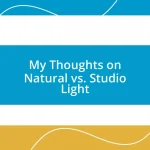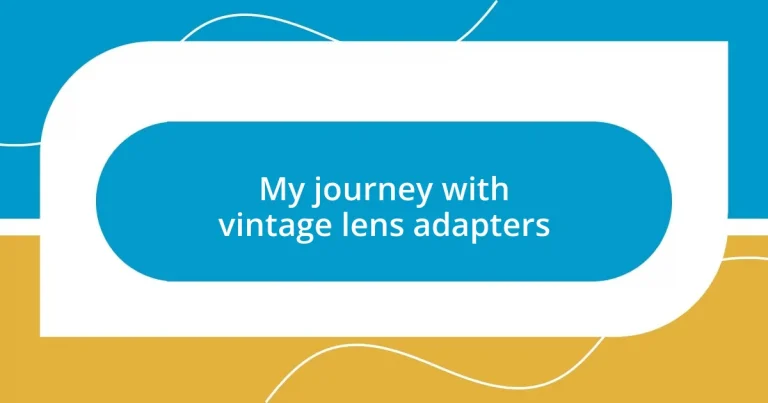Key takeaways:
- Vintage lens adapters connect retro lenses to modern cameras, enhancing creativity and adding character to images.
- Choosing vintage lenses involves considering optical quality, focal length, mount compatibility, lens condition, and unique characteristics.
- Attaching adapters requires careful alignment and practice, with attention to any electronic features for better usability.
- Creative techniques like tilt-shift and unconventional lighting can unlock new photographic perspectives and enhance the capture of fleeting moments.
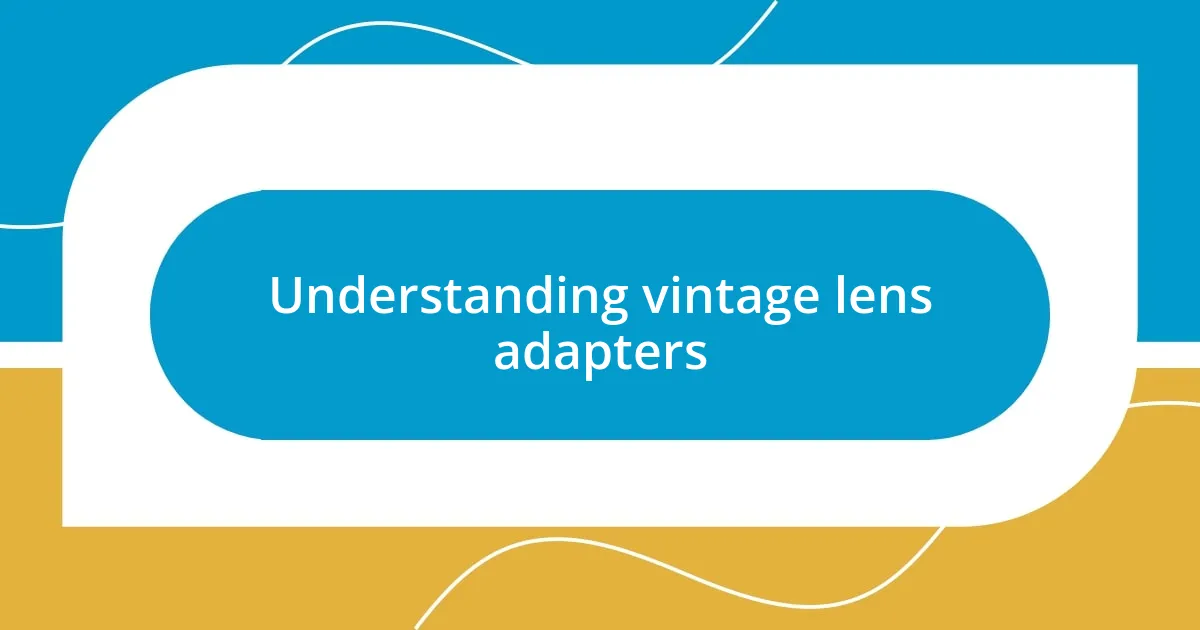
Understanding vintage lens adapters
Vintage lens adapters are fascinating tools that bridge the gap between retro optical systems and modern cameras. I still remember the first time I attached an old Canon FD lens to my digital camera; it felt like unlocking a treasure chest of nostalgia. The way light danced through those vintage glass elements was captivating, and it made me ponder—what stories did that lens capture back in its prime?
Now, while using these adapters, it’s crucial to understand their mechanics. Some adapters maintain infinity focus, allowing you to capture crisp landscapes just as the original lenses intended. Others may not offer that luxury, leading to experimentation with closer subjects—drawing out a sense of creativity that often feels like a secret dialogue with the past.
What truly excites me about vintage lens adapters is the uniqueness they bring to each shot. Every click of the shutter reverberates with history, adding a character to images that modern lenses sometimes lack. Have you ever felt a pull toward a certain lens just because of the stories it carries? It’s an emotional connection that goes beyond technical specifications, making each photographic endeavor a personal journey into the world of vintage optics.
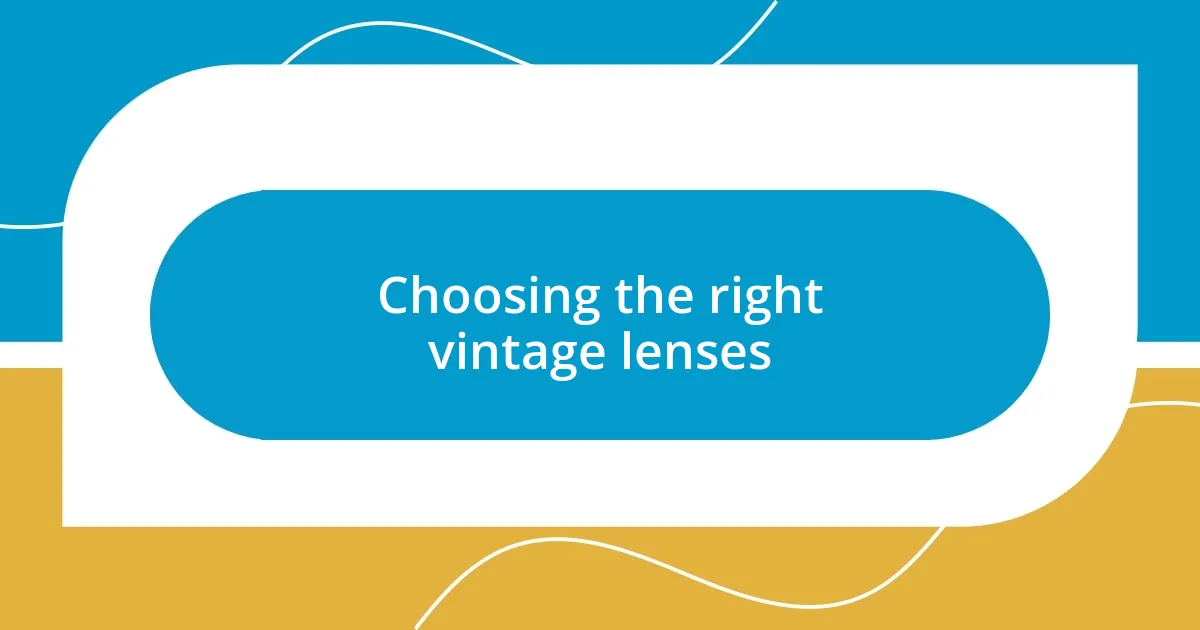
Choosing the right vintage lenses
When it comes to choosing the right vintage lenses, personal preference plays a significant role. I’ve often found that my selection process hinges not only on optical quality but also on the emotional allure of the lens itself. There’s something truly exhilarating about holding a well-worn piece of history; it whispers stories of the moments it captured long before it found its way into my hands.
Here are some key factors to consider when selecting vintage lenses:
- Optical Quality: Research the lens’s reputation in terms of sharpness and distortion.
- Focal Length: Determine what type of photography you enjoy most (portraits, landscapes, etc.) to guide your choice.
- Mount Compatibility: Ensure the lens can be adapted to your camera body, as not all vintage lenses will easily fit.
- Build Condition: Inspect for scratches, fungus, or haze—these issues can heavily impact image quality.
- Character: Some lenses produce unique bokeh or color rendering—how do you want your images to feel?
Back when I was navigating the vintage lens market, I stumbled upon a Helios 44-2. It had that beautiful swirly bokeh that seemed almost magical. The first time I shot with it, the photos were filled with dreamy backgrounds, making even mundane scenes come alive. It wasn’t just the lens quality; it was the excitement of uncovering something special and infusing my work with a sense of artistic flair.

How to attach lens adapters
Attaching lens adapters can feel a bit daunting at first, but I assure you it’s a straightforward process with some practice. I recall the initial struggle I faced when trying to couple my vintage Helios lens with my modern DSLR, unsure if I was doing it right. The key is to align the adapter with your camera’s mount, and once you hear that satisfying click, you know you’re on the right track.
Next, it’s essential to gently twist the lens onto the adapter, taking care to keep the alignment correct. I learned this the hard way—once, I forced a lens into place, and I ended up with a slightly bent connector, which impacted my ability to achieve sharp focus. Patience is crucial; always make sure everything lines up before applying pressure. It’s a tactile experience, and with each successful attachment, I felt more connected to the vintage gear I was using.
Sometimes, different adapters come with features such as built-in aperture control or electronic connections. If you plan to use an adapter with advanced features, make sure to read the instructions thoroughly. I still remember when I got my first adapter with electronic control; it was such a revelation how smoothly I could adjust the aperture without removing the lens. This experience deepened my creative process, allowing me to focus more on composing shots rather than fiddling with mechanics.
| Step | Description |
|---|---|
| Align Adapter | Line up the adapter with your camera mount and ensure it’s secure. |
| Attach Lens | Gently twist the lens onto the adapter until it clicks into place. |
| Check Alignment | Verify that everything is aligned before applying pressure. |
| Use Features | If applicable, familiarize yourself with any electronic controls on the adapter. |
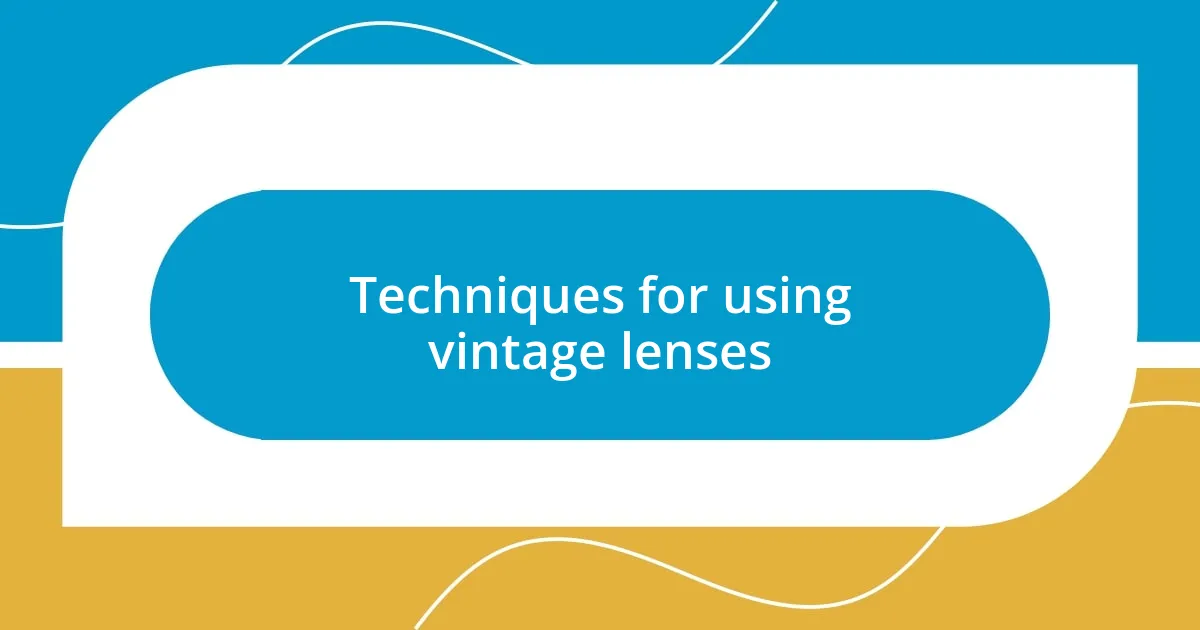
Techniques for using vintage lenses
Working with vintage lenses involves some unique techniques that can really enhance your photography. I’ve found that embracing manual focus can be quite liberating. It forces you to slow down and truly consider your composition, which often leads to more meaningful shots. Have you ever noticed how the act of fine-tuning focus can add a tangible connection between you and your subject? For me, the feeling of nailing that perfect focus point is incredibly rewarding, as it often leads to a moment that feels special and one-of-a-kind.
When shooting, I recommend experimenting with different apertures to discover the signature look of each lens. I recall a day spent with an old Pentacon 50mm, cranking it wide open to f/1.8. The soft, dreamy backgrounds it produced made my portraits glow in a way that surprised me. That particular lens has a character all its own, bringing a sense of nostalgia to my images that I couldn’t replicate with my modern glass. It’s exciting how small adjustments can lead to dramatically different results—do take time to play around with settings until you find what resonates with you.
Don’t overlook the importance of understanding how the lens’s own limitations can affect your shots. I learned this when using a vintage lens with a fixed aperture; I had to adapt my shooting style accordingly. Rather than worrying about changing light conditions, I focused on the interplay of shadows and highlights in the scene. This shift not only challenged me creatively but also led to some of my favorite shots. Have you ever had a limitation push you to explore new artistic avenues? Reflecting on those experiences can provide a greater appreciation of the craft.
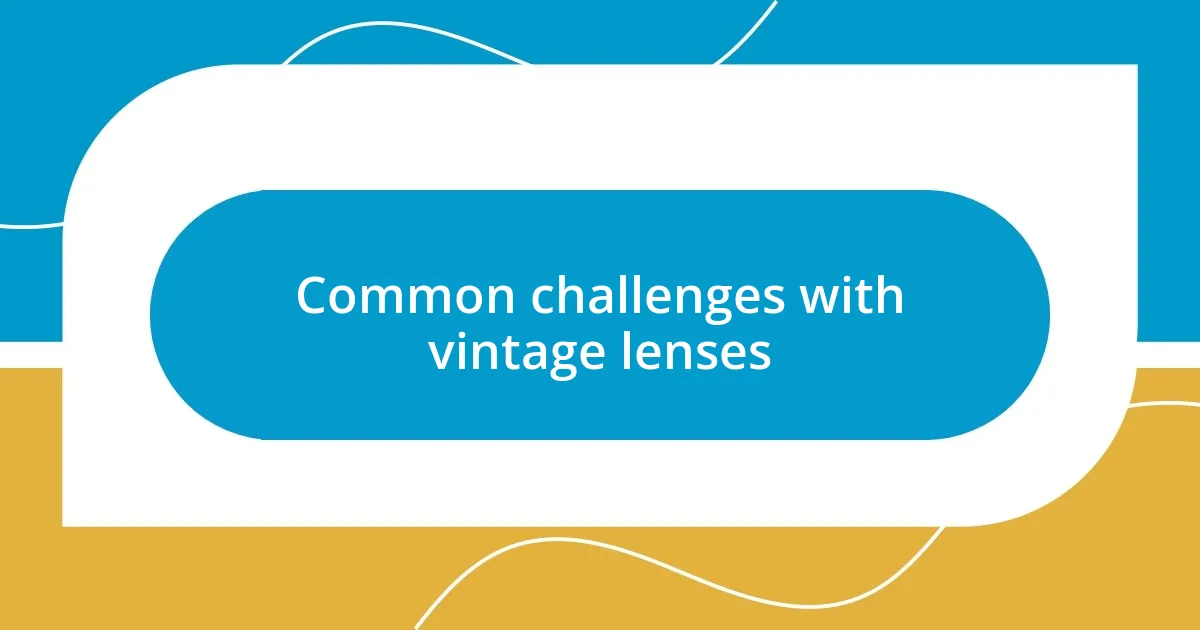
Common challenges with vintage lenses
When diving into vintage lenses, you’ll often encounter quirky challenges that modern lenses simply sidestep. For instance, many older lenses don’t have the same autofocus capabilities that we’ve grown accustomed to. I remember my first shoot with a vintage Takumar; it was a stark realization that I’d have to rely solely on my manual focus skills. Sure, I fumbled a bit, but it turned out to be a rewarding lesson in patience and precision. Have you ever had a moment where you felt technology stripped away, forcing you to reconnect with the act of photography itself?
Another hurdle that comes with vintage lenses is the potential for image quality issues. Many older lenses are prone to things like flare or vignetting, which, while sometimes charming, can be frustrating. I vividly recall using a 1960s Jupiter-9 lens on a bright sunny day and being pleasantly surprised by the beautiful bokeh it produced, yet wishing I had a lens hood to combat that pesky flare. It presented a duality of emotion: frustration over the limitations, yet excitement over the unique character these imperfections could add to my shots. Have you experienced that tension—the push-and-pull of wanting clarity but also embracing the flaws?
Finally, adapting vintage lenses can often lead to compatibility headaches, especially when dealing with different camera mounts. I once tried using an old Nikon lens on a Canon body with an adapter, only to discover that the compatibility issues diminished my ability to use certain settings, like aperture control. That experience forced me to learn more about my gear and ultimately made me more resourceful. Have you taken the time to really explore the technical aspects of your equipment? Each new challenge teaches us something valuable, deepening our relationship with our craft.
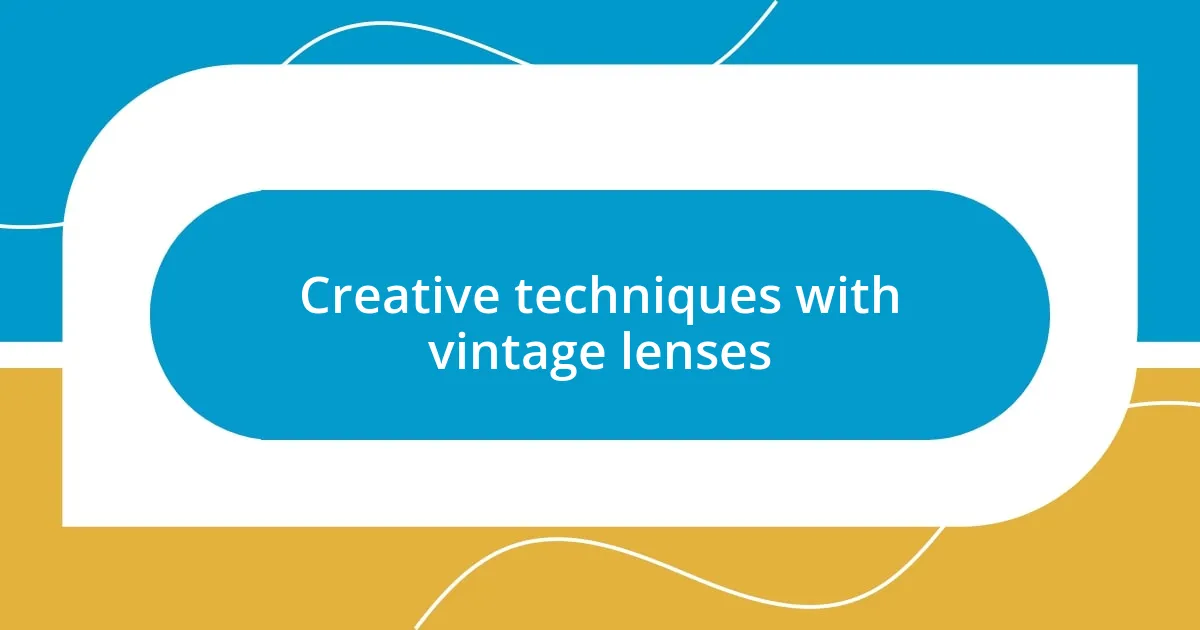
Creative techniques with vintage lenses
Exploring creative techniques with vintage lenses can truly open up new dimensions in photography. One fun approach I’ve enjoyed is using lens tilt techniques to introduce a miniature effect, often referred to as “tilt-shift.” A quirky experience stands out for me when I employed my old Helios 44-2 lens for this purpose. The resulting images turned everyday scenes into tiny worlds, making me feel akin to a child playing with a model city. Have you ever looked at something familiar and felt transformed by a new perspective?
Another exciting method is to play with layering, both with shots and in compositions. I’ve found that using vintage lenses gives a lovely ethereal quality to foreground elements. For instance, while snapping a few shots of flowers in a sun-drenched park, I purposely included some leaves in the foreground to create depth. The soft bokeh and character of the vintage lens made those flowers seem to float in a dreamlike space, capturing a fleeting moment beautifully. Isn’t it amazing how just a slight shift in your framing can dramatically alter the outcome?
Lastly, incorporating unconventional lighting can yield striking results with these lenses. I once ventured out at dusk, armed only with my Vivitar 28mm, and I shot into the setting sun. The lens rendered the warm colors with an unexpected richness, almost like painting with light. That day, I learned the importance of experimentation; every lens has its own personality that shines through differently in varying light. Have you taken the opportunity to explore how light interacts with your vintage gear? These moments can lead to discoveries that deepen your understanding of both your tools and your artistic vision.

Maintaining and caring for lenses
Maintaining vintage lenses is vital to preserving their charm and functionality. I always make it a habit to inspect my lenses before and after each shoot. Just last week, while preparing my beloved Helios 44-2 for a sunset session, I noticed a bit of dust on the front element. A gentle blow followed by a soft microfiber cloth saved the day, ensuring my images would be clean and clear. Have you ever found small imperfections that, when fixed, made a world of difference in your shots?
Regularly checking the moving parts of your lenses can also help keep them in good condition. I’ve had an instance where I neglected the aperture blades of an old Takumar, only to discover they were sluggish during a crucial shoot. It was a valuable lesson for me. A little oil and proper exercise can make all the difference, and now, I prefer to spend a few extra minutes cycling the aperture before heading out. How do you ensure your lenses are ready for action each time you pick them up?
Lastly, proper storage is essential for vintage lenses. I learned this the hard way after leaving one of my prized lenses in a damp place, which led to internal mold. Now, I always store my lenses in a dry, temperature-controlled environment, ensuring they’re in protective pouches or cases. It’s these small, proactive measures that can extend the life of our treasured glass. Have you taken the time to think about how and where you store your equipment? Every lens holds a story, and maintaining it means ensuring that story continues.








